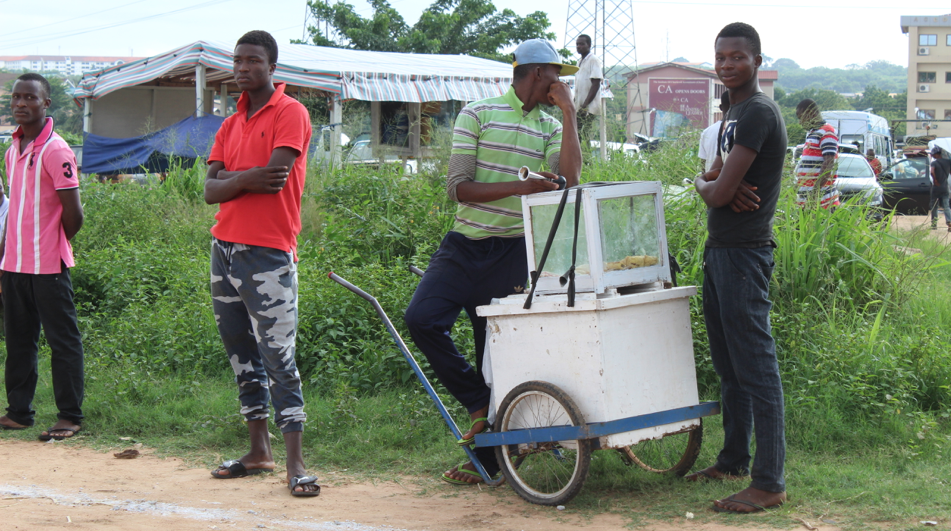June 21st, 2015 — Soccer is championed worldwide as the most popular sport on earth. Although simple in concept, it is a game that transcends economic barriers which often pervade in others. Take a sport as celebrated as rugby for example — you need to be able to afford the equipment necessary in order to play the sport safely and hire a referee. In a sport as widely beloved as basketball, you need to wait on someone in the community to spend the funds needed to erect a hoop. In soccer, all you need at the minimum is access to a ball, the ability to scavenge for items to mark the posts of a goal (which often includes the patience to deal with arguments between your buddies on whether a goal “went in” or if it skimmed into the “post”) and if possible, someone in the neighborhood with the ability to put friendships at risk in order to act as the match official. Today, I had the opportunity to come face-to-face with the role soccer plays in Ghanaian community as well as why the sport is truly the “game of the people.”
Having touched down in Accra late last night after a 16 hour flight, many among us were very jet lagged. In the late afternoon, following a long bus tour around the capital city, we learned of a soccer game between two schools nearby where we were staying in East Legon. We all immediately reached for our cameras and slipped out the door into an unfamiliar world.
After a short walk through roads lined with tin-walled shops, we came across a dirt opening to where the match was to be played.
On either side of the field were two goals made up of three long metal poles that were strapped together; charcoal was impressively laid out from the posts across the perimeter of the field and sprinkled down the halfway line. Even the center circle seemed to be perfectly round and encompassed a kick-off mark.
The sight of 15 obrunis (the local term for ‘foreigners’) holding fancy cameras called for a befuddled reception. We seated ourselves, awkwardly lined up under the shade of a hanging tree, as community members started flowing in from all corners of the open field. One of us had jet lag get the better of her; overwhelmed with how sleepy she felt in broad daylight, she fell asleep in the dirt, which didn’t quite help as we tried not to stand out.
Little boys slowly inched towards us, smiling before retreating back, while groups of teenage guys and girls beamed at us from a distance — many of them clad in uniform and still wearing their backpacks. Meanwhile on the field, young laughing toddlers nudged and chased miniature balls with their feet, weaving in and out the charcoal-laden pitch sideline.
Suddenly, the players of the match-up, aged to be around 16 or 17, entered the clearing on bicycles, and the chasing younglings cleared the pitch in haste. The two sides began stretching and conducting drills on opposite ends of the field. One side wore what were mostly fake Barcelona orange away kits, while the other side wore absolutely anything they pleased. A player from “wear-what-you-want” F.C. moved off to the side of the pitch to where a group of his buddies were watching and starting flicking keepie-uppies, knocking the ball with the upper center, inside, and outside of his feet; the thighs of his legs; whipping the ball up to the tip of his head, and fitting in a chest bump or two preceding a drop back to his waiting feet. In a way that was all too familiar among a close group of friends — the way they often keep their mates in check if one of them were to blatantly show off — his buddies laughed at him and made sure to give him a hard time when the ball went rogue off a mistimed juggle and rolled in the dirt.
A young man, looking about the same age as the players, walked on to the middle of the pitch — he was to be the noble referee of the match. He twiddled his whistle on a strap, and sashayed around, having a laugh with a few players from both sides. Facing complaints from the other players who weren’t included in this man’s effervescent conversation, the match official, with final a cold look, broadened his shoulders, and transformed into the arbiter of the game. He set up the coin toss, which “Barcelona” won, and blew the whistle to commence the match.
The ball moved around the pitch, and, upon its arrival at the boot of a player, became the source of rough tussles. There were some very technical players on the field who had their footwork tested, especially when a player would receive the ball tight against the sideline and had to rely on sheer wit to take on rushing opposing players. I chuckled in amazement as a midfielder from Barcelona, who hooked the ball right in front of where I was standing, did a quick rhythm-breaking step-over to fool two challengers before sliding the ball to the side of his left toe, and in a curtsey motion, whipped the ball high over to his center-back to keep the ball in his team’s possession.
Finally taking my eyes (and camera lens) off the game, I came to realize that the area around the field had become absolutely packed with spectators — a rough count brought me to 180 and now mostly consisted of full-grown men. How such a high number of people had managed to enter around me without catching my attention made me take notice to the fact that the atmosphere of this game was a little different to what I was used to in high school soccer games back in the United States.
In this soccer match, there was not a whole lot of cheering. When a goal was netted in, most of those who were watching intently, continued to gaze on with their arms folded. The loudest claps and cheering seemed to come from either us, from where we were underneath the tree, or the coaches from the side of whichever team scored. The audience consisted of all ages and walks of life: from dress shirt business men, en route from work, crouching among the audience, to Adinkra pastry vendors leaning up against their carts and conversing with their buddies. Schoolboys in blue polos and khakis wrestled behind Barcelona’s substitutes and stopped to laugh as a drunken old man swayed past and muttered to himself. I met Nana, a 19-year old mason from Côte d’Ivoire, who was rocking over his bike next to where I was taking pictures. I asked him which side he was going for. “Nobody” he said, “I just come here to relax and watch the game.”
It was fascinating for me to see how a high school soccer match could serve as a force of bringing so many members of the community together, but for a lot of those who were present, little of the attention was on who was actually winning the match — none of the spectators seemed to be expressing any outright support for one team over the other. Life just seemed to go on outside the pitch as people interacted with each other after a busy day’s work or watched alone and were calmly taken in by the rhythm of the match.
With the emerging popularity of soccer in the United States, many sports journalists like to articulate the “game of the people” sensation of soccer with some of the stories of our own American soccer stars, such as the “rags to riches” story of Clint Dempsey, who grew up playing soccer at a trailer park in Nacogdoches, Texas, and went on to become an international star.
However, in the United States, this may be losing its basis in reality. Back at the University of Oregon, I recall how a close friend of mine who had played as a defender for his high school soccer team in Salem described to me how only those who were able to pay the costly price of enrolling in summer training camps and soccer academies were given a place on the high school team. He attributed this as a reason why his team was overwhelmingly made up of caucasian players.
Meanwhile in the news, the 2015 FIFA corruption case continues to uncover top officials engaging in fraud, money laundering, and bribery, which are unfortunately commonplace in the world of professional soccer. It leaves a rancid taste, knowing that the game’s governing body, which is supposed to protect the game from falling from the hands of the people and into the clutches of the powerful, are the ones engaging in the corruption themselves.
However, today in East Legon, I believe I witnessed the sport’s mission of providing worldwide inclusivity and fraternity in its finest form.






Comments by jaclynr